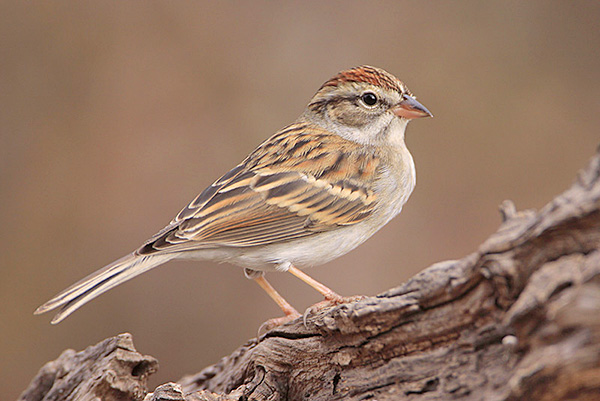The Chipping Sparrow is a traditionally pretty songbird. They’re very crisp looking and have a bright rufous cap. Their unique pattern and coloring provide a splash of color and make adult Chipping Sparrows one of the easier species to identify. They have relatively long tails, are slender, and have medium-sized bills.
Chipping Sparrows are common birds that can be found across North America wherever there are grassy openings surrounded by trees. These birds have trilling, loud songs and are one of the most common sounds of spring suburbs and woodlands.
Small flocks of Chipping Sparrows can be seen in the fall and winter, feeding on open ground near trees. In spring and summer, male Chipping Sparrows are very vocal and produce long, loud calls. You’ll often see them in trees on the upper branches.
On this page
Identification
In the Summer, Chipping Sparrows have a crisp, clean look. They have pale faces, frosty underparts, black lines through the eyes, and bright rusty crowns. In the Winter, Chipping Sparrows are muter.
They’re buff brown and have dark streaks on their upper parts. However, the black lines through the eyes are still visible, and the crown is a duller reddish brown.
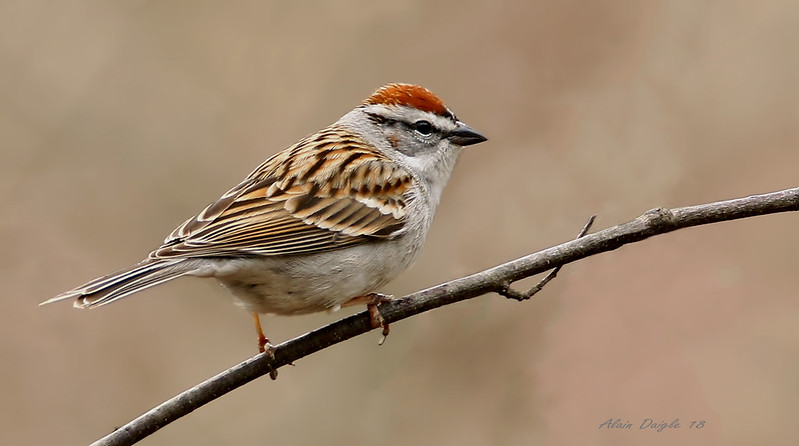
© Alain Daigle
These birds are shorter-tailed, trimmer, smaller than Song Sparrows, and a little bit bigger than a chickadee.
Female Chipping Sparrows look identical to males. In the summer, they have pale faces, frosty underparts, black lines through the eyes, and bright rusty crowns.
In the winter, they’re buff brown with dark streaks on their upper parts. The black lines through the eyes are still visible, and the crown is a duller reddish brown.
Females are the same size and length and have the same wingspan as breeding males. They also weigh the same amount.
Food
Chipping Sparrows primarily eat seeds. They tend to go for seeds that come from a wide variety of herbs and grasses.
During their breeding season, Chipping Sparrows will hunt for protein-rich insects like caterpillars, grasshoppers, beetles, true bugs, leafhoppers, and spiders. Chipping Sparrows will sometimes eat small fruits as well.
Chipping Sparrows will visit backyard bird feeders. They like sunflower seeds, safflower seeds, millet, and suet.
They prefer to feed on the ground, so you can put out a ground feeder or sprinkle seed along the ground under your existing feeders.
Nesting and Eggs
Female Chipping Sparrows build their nests anywhere from 3 and 10 feet off the ground. They’ll hide the nest in foliage at the end of a tree branch.
These birds tend to gravitate toward evergreen trees, but they have been seen building nests in honeysuckle tangles, ornamental shrubs, crabapples, maples, and other deciduous tree species.
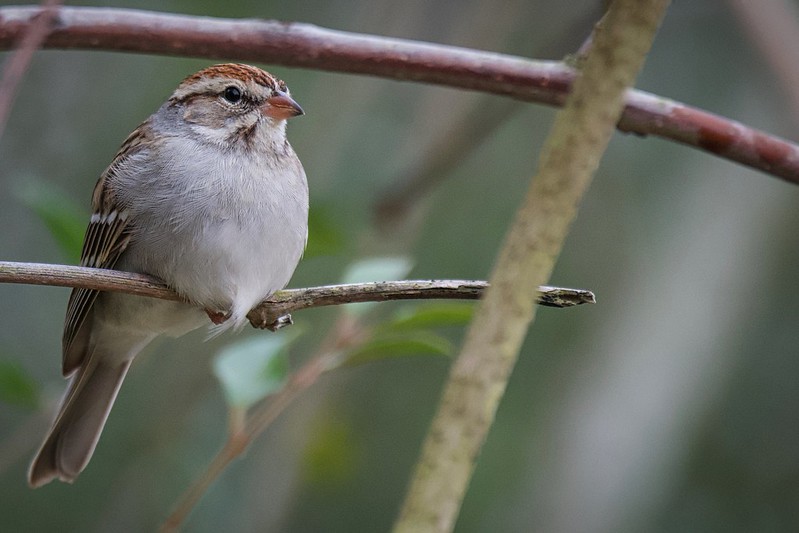
© Kevin Milazzo
Female Chipping Sparrows are picky about where they place the nest; It’s not uncommon for them to start building a nest in one spot, abandon it, and create another nest elsewhere.
Male Chipping Sparrows will guard females while they build the nest. However, they don’t help create the nest.
A female Chipping Sparrow takes 3 to 4 days to complete her nest. The nest is a loose cup made of dry grasses and rootlets. It’s usually so flimsy that you can see through it.
Next, she’ll line the nest with fine plant fibers and animal hair. The nest will measure around 2.2 inches deep and 4.5 inches wide when it is complete.
- Clutch size is 2 to 7 eggs.
- Chipping Sparrows will have 1 to 3 broods per breeding season.
- Egg length can be anywhere from 0.6 to 0.8 inches (1.5 to 2 centimeters).
- Egg width can be anywhere from 0.4 to 0.6 inches (1.1 to 1.5 centimeters).
- The incubation period is 10-15 days.
- The nestling period is 9 to 12 days.
- Eggs are white to pale blue. They’re often lightly spotted or streaked with brown, purple, or black.
Current Situation
Chipping Sparrows love to forage along the ground, but you’ll find them hanging in and around trees, woodlands, grassy forests, shrubby or tree-lined backyards, and parks.
When available, Chipping Sparrows will choose evergreens before any others. If evergreens aren’t available, they’ll use birch, aspen, oak, eucalyptus trees, and pecan. In the mountains, Chipping Sparrows can be found all the way up to the tree line.
Chipping Sparrows are common birds that can be found across North America. However, there was a population decline of 0.6% per year from the late 1960s to 2019.
Their estimated breeding population is 240 million. As a result, they’re considered a species of low concern. Chipping Sparrows thrive in tree-filled, open spaces in parks and suburbs.
Facts
- The Chipping Sparrow is separated into two groups: the Western Chipping Sparrow and the Eastern Chipping Sparrow.
- The oldest recorded Chipping Sparrow lived to be at least 10 years and 11 months old. It was first captured and banded in Ontario in 1987. It was recaptured and rereleased in the same region in 1998.
- During nesting season, female Chipping Sparrows develop a bare patch on their stomachs. This bare patch is filled with fluid and helps transfer heat to the eggs during incubation.
- Chipping Sparrow nests are so flimsy that light can be seen through them. Therefore, it most likely provides little insulation for the eggs during incubation and young when they hatch.
- Chipping Sparrows migrate at night. Their flight calls are a common sound that can be heard in the night sky in fall and spring in the U.S.
Similar Species
The Chipping Sparrow has features that are similar to other bird species. Here are some similar species:
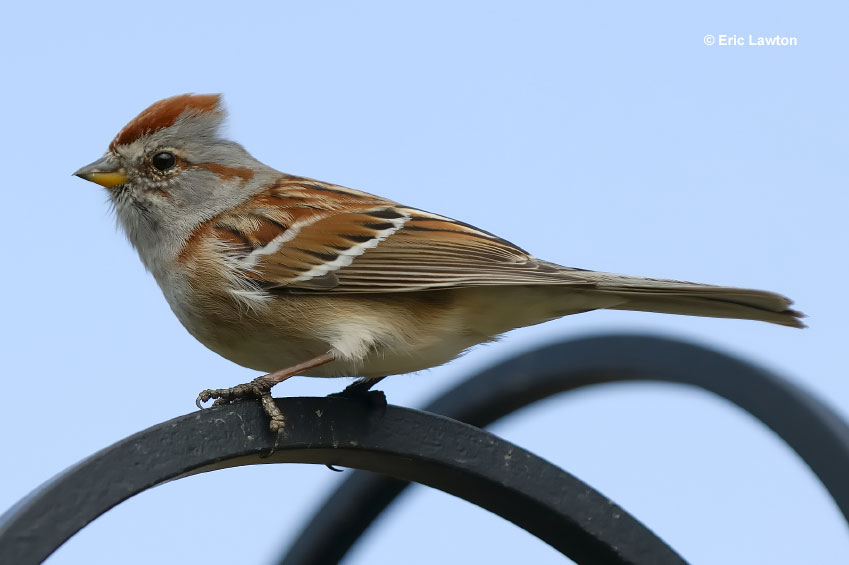
American Tree Sparrow
Chipping Sparrows have a black stripe through the eye, while American Tree Sparrows have a rufous-orange stripe through the eye.
Additionally, American Tree Sparrows have a spot in the center of their chest, while Chipping Sparrows do not.
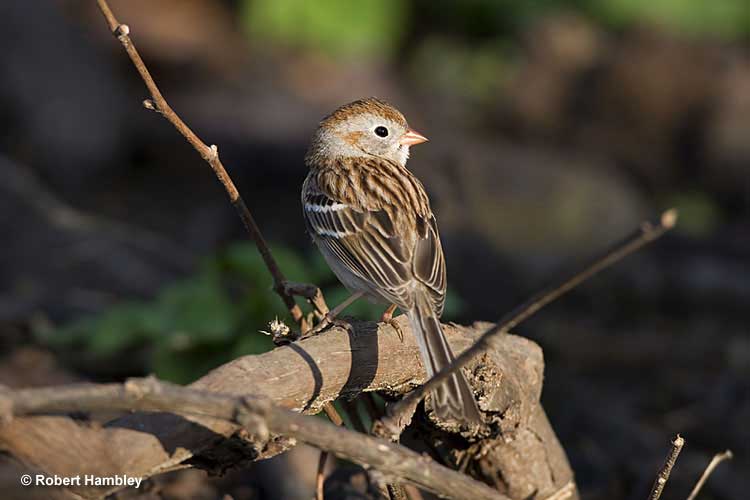
Field Sparrow
Chipping Sparrows have a black eye line, not an eyering, dull bills, and bright, rusty crowns.
Field Sparrows have bold eyerings, bright-pink bills, and duller crowns.
Frequently Asked Questions
Why are they called Chipping Sparrows?
Chipping Sparrows get their name from a call they make. They make a sharp “chip” sound that can be heard throughout the day when interacting with others and foraging.
Are Chipping Sparrows rare?
No, the Chipping Sparrow is not rare. These birds can be found throughout North America and have a stable population.
How do you identify a Chipping Sparrow?
In the Summer, Chipping Sparrows have a crisp, clean look. They have pale faces, frosty underparts, black lines through the eyes, and bright rusty crowns. In the Winter, Chipping Sparrows are muter. They’re buff brown and have dark streaks on their upper parts. However, the black lines through the eyes are still visible, and the crown is a duller reddish brown.
Where do Chipping Sparrows go in the winter?
The northern Chipping Sparrow populations migrate south and winter in the southern United States and Mexico. These birds migrate in flocks.

